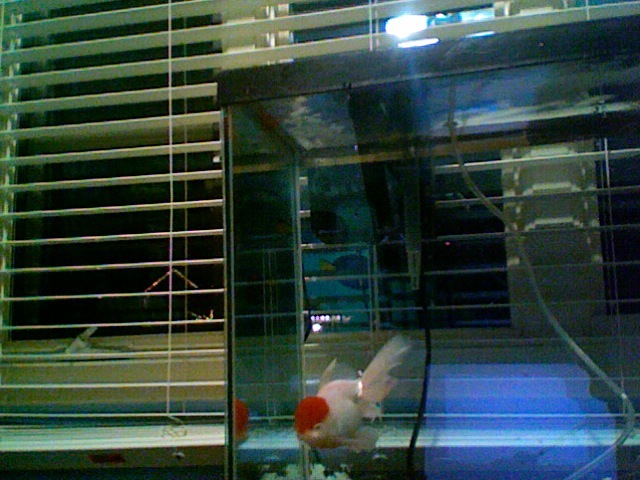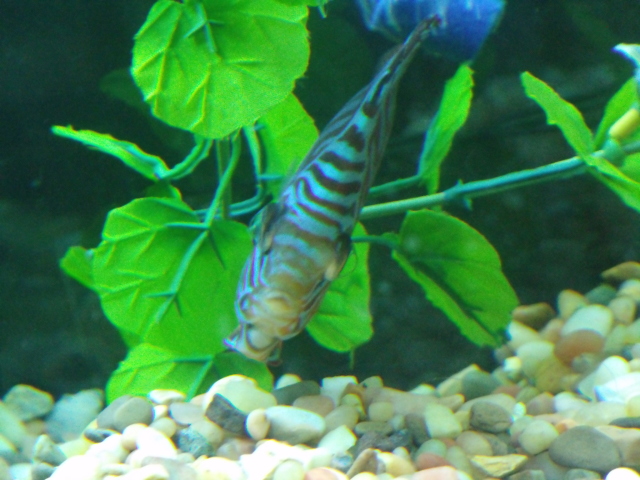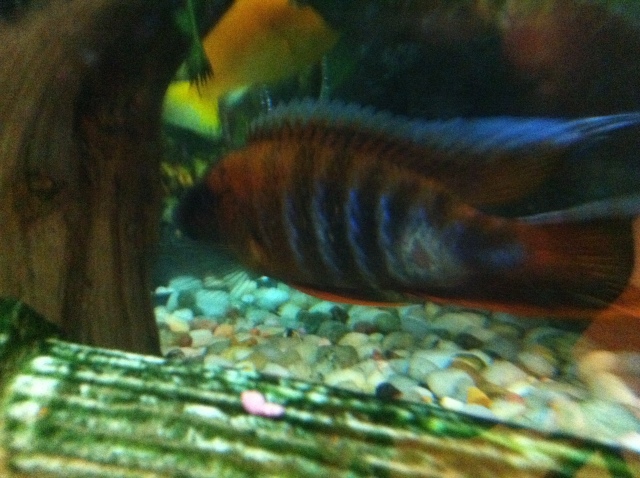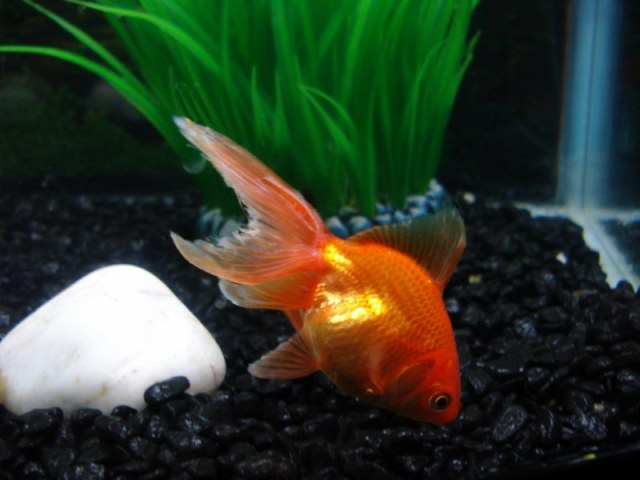QuestionHi Karen,
I saw your excellent answer to a man named Davids problem and I thought I should try this out. Its good that you're willing to share your knowledge. I just started a 55 long Freshwater Tank. I have a power filter and a backpack. I have good circulation but I was wondering if you could help me set up a schedule for water tests and water changes.
I started this project hoping to create a Freshwater River Tank. With a variety of catfish. I only want semi-aggressove fish. Such as barbs and bala sharks. Maybe a select few Discus.
If there is anything extra you think I need to know. Just let me know. I am all ears. I'm a horse pesron myself, but I am very interested in learning the world of Aquatics.
Thanks for your time,
Jessica W.
AnswerDear Jessica,
You started with a good sized aquarium! 55gallons is a very good size aquarium and there are many possibilities with a tank like this. I know a few tried and true stocking schemes for aquariums of this size adapted from the best all-around aquarium book I have read-- "The simple guide to freshwater aquariums" by David E. Boruchowitz. I highly recommend you read this book if you can find it at your local library or better yet, purchase it at your bookstore or try amazon.com it's a great book to have on hand as reference if you run into trouble.
You've got a good idea by starting a Freshwater River tank theme. But I'm afraid bala sharks may not be suitable long-term for the tank of your size. These are fast moving and can grow quite large up to 14" if well cared for and a small group would really be best off in a aquarium of a hundred gallons or so. However, all locally available species of barbs would be suitable---except the Tinfoil barb. Although these are one of my favorite fish, I have owned them for years and learned that they do best in as large a tank as you can manage which ideally is in the range of 100 gallons or more. However, Tiger barbs, Cherry barbs, rosy barbs, gold barbs, or black ruby barbs are all suitable for your aquarium and are very beautiful and interesting schooling fish I highly recommend. I currently own a school of Rosy barbs and they are some of the most colorful barbs. All barbs are bold and unafraid to come out in the open and interact with each-other or other fish.
One stocking scheme from Mr. Boruchowitz book is all barbs-
~First, the aquarium is cycled with 10 Cherry barbs. These are lovely fish all the time, but in spawning condition males become a rich velvety cherry red color all over. Which will counterpoint with the females' black and tan and cream colorations
~Next, Once the aquarium is cycled, you may slowly build up two more schools of barbs, 8 Black Ruby barbs and 10 Tiger barbs. Tigers come in a very unique green "moss" color variety as well as albino. Mixing the different colorations makes for a very interesting display and is perfectly fine since they are all the same species.
*This is the stocking scheme for 'all barbs' but there are also other stocking schemes you may be interested in such as-
~'Fish that are a big larger'~ scheme
2 pairs of Blue Gouramis cycle this aquarium. This species also comes in many color morphs similar to the Tiger barbs. There are color varieties such as Opaline, gold, blue, and platinum. You should always have pairs (male and female) or all females to reduce some aggression in the tank. Males and females are easily told apart by their dorsal fin. In males, it is much longer and pointed while the females is short and neatly rounded. These gouramis (like most all) have speciall thread like fins that are their "feelers" that they touch objects and even other fish with to explore their enviroment better. Gouramis are also capable of breathing atmospheric air by taking small gulps at the surface regularly..This is because Gouramis originate from often oxygen-depleted habitats in nature.
-After Cycling, the gouramis are joined by 4 Swordtails of any color type and a school of 8 Rosy barbs completes this grouping.
Stocking Scheme 3#: An Asian Accent
This stocking scheme is made up of fish all from Southeast Asia.
A school of 10 White clouds cycle this tank. These are delightful and lovely little fish, very hardy and colorful!
Next, two more schools of fish are gradually added-
8 Gold barbs, and 15 Harlequin Rasboras...Both the colors and iridescences of these fish complement each other but their behavior is also vastly different. From the bold and active Goldfish to the more retiring Rasboras.
*Finally a pair of Dwarf Gouramis completes this grouping. These are some of the most beautiful of the gouramis. The males have a blue and red striping pattern on their sides while the females have a subdtle beauty all their own with a coloration of greenish silvery. You may also try having two pairs of dwarf gouramis.
Last but not least, there is a "typical" community stocking scheme that provides both interesting and easy to keep species which will all get along together.
-Typical community-
5 Platies are used to cycle this tank, platies come in a huge range of colors and patterns all are beautiful.
Next, Danios are quick and uniquely patterned fish which look great in large schools. A school of 8 will provide non-stop action and plenty of metallic iridescence. You could try Giant danios which are almost like large versions of the Zebra danio..Or simlpy choose one of the smaller species. Lemon tetras are one of my favorite tetras and are truly lovely fish. Often overlooked in stores because of their dullness, this is only due to being stressed in the dealer's tank. Once you bring them home and get them established in your aquarium they will color up into a true lemony color. Also, 6 Serpae tetras makes another school in this theme.
And finally, the lower levels of this aquarium will be a home to Corydoras catfish (also known as cory cats or just cories) these catfish stay small (2 inches maximum) and are some of the cutest catfish out there! All spceis are peaceful and do a good job cleaning up leftovers in your tank. But they must be also be fed special sinking foods and frozen foods for them to thrive. A school of 6 completes this stocking theme.
Discus really do best in a calm and quiet aquarium with equally calm and quiet tankmates. Discus ideally are best suited to live in a aquarium that is well-heated and well maintained to about 80F or a bit higher and they require good commitment on their owner's part. Discus require plenty of frequent large water changes. Basically what I'm trying to say is discus need an aquarium devoted to them, paying attention to all their special needs and building the enviroment and tankmates around their needs to thrive. If you would like to devote your aquarium to discus, be sure to read up on them as much as you possibly can and set up your aquarium with their best interest in mind.
As for water testing and water changes. When you first start up your aquarium, you must cycle it or establish the special beneficial bacteria which are so vital for any aquarium life to be healthy. These bacterial consume and convert dangerous ammonia into nitrite, then more bacteria convert the nitrite into nitrate which is the least toxic of them all and is removed by your weekly/twice weekly water changes. Establishing these bacterial colonies takes weeks and plenty of patience. You can use a few cycling fish but you must be sure to test your water everyday for ammonia and nitrite and be sure to make those essential 50% water changes whenever any of these levels goes above safe bounds. Always insure when making replacement water to always treat it with water conditioner such as amquel plus and always insure the replacement water is equal in temperature to that of your aquarium.
Be sure to not add anymore fish to your aquarium while it is cycling to avoid any unecessary ammonia spikes. Once your aquarium cycles (which is indicated by consistant Zero ammonia and nitrite readings) you can slowly stocking your aquarium with a few fish per week..Never all at once. This would overload your beneficial bacteria colony and would result in a dangerous spike in ammonia. The beneficial bacteria needs time to adjust to new bioloads put on it.
The important things to remember are- Be patient ( I would imagine a horse person is a patient person anyway!) and focus on getting your aquarium cycled sucessfully before fully stocking it with fish. Patience and knowledge is very important in aquarium keeping. It's very important to research thoroughly any fish species you had in mind before buying. A good fish book like the Simple Guide to Freshwater aquariums is very important to have on hand. Sometimes internet sources have false information..but not always.
Once you get your aquarium cycled and well established you can begin a water changing schedule according to your individual aquarium. There is really no strict guideline as to when you should change your water nor a strict rule to a 'percentage' It is all based on your own aquarium and pollution level. I tend to try to do a good sized water change twice a week on all my aquariums. More is always better. It is said (And i highly believe) that water changes are the best thing you can do for your fish. In nature, fish would almost never have to deal with a polluted enviroment due to their own wastes as the sheer volume of water would dilute it and wash it away, aquatic plants would also absorb much of the pollution. And unless the pollution is man-made, fish are always in fresh and clean water in nature. I feel we should try to duplicate that as much as possible. Just always be sure your replacement water is dechlorinated and equal in temperature to that of your aquarium.
Once your aquarium is well-established then weekly testing it good. You generally don't need to worry about adjusting your pH level as the huge majority of commonly kept fish are highly adapted and can thrive in varying levels of pH as long as it's stable. You will also want to test your water whenever your fish seem "Off-color" or otherwise listless. As always, if in doubt, do a water change.
Aquariums take good responsibility and understanding of aquatic life...Much like any other animal, including horses! If given the best care possible, keeping aquarium fish is a very enjoyable hobby and can expand into dozens of aquariums and some aquarists devote a whole room to their fish known as their 'fish room'. I really hope you enjoy your new aquarium and can take these tips and use them to your best advantage..Still, I recommend you research as much as you can. Books tend to be the best information surfaces as well as published magazines such as Tropical fish hobbyist magazine. And of course, if you need anymore help, feel free to write.
I appreciate you taking the time to read all this too. I only want the best for all fish and tried to give as much info as possible.
And Thank you so much too, I appreciate your nice comments and thanks for chosing me as your 'expert'!
Best wishes,
Karen~

 My new Oranda
Questionoranda
QUESTION: My new Oranda has Red S
My new Oranda
Questionoranda
QUESTION: My new Oranda has Red S
 Discus with popeye not eating
Questionpopeye, possible hole
QUESTION: I was d
Discus with popeye not eating
Questionpopeye, possible hole
QUESTION: I was d
 Sick cichlids! i dont want to lose them
QuestionQUESTION: Hello Renee, first off, thank you for
Sick cichlids! i dont want to lose them
QuestionQUESTION: Hello Renee, first off, thank you for
 Yellow Platy with Spots
Question
Yellow Platy with spot
Large white spot
Yellow Platy with Spots
Question
Yellow Platy with spot
Large white spot
 Goldfish - tank move - fin rot
Question
Professor the fantail
Hi,
I was given three f
Goldfish - tank move - fin rot
Question
Professor the fantail
Hi,
I was given three f